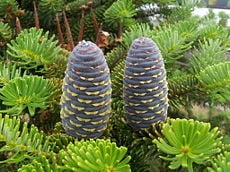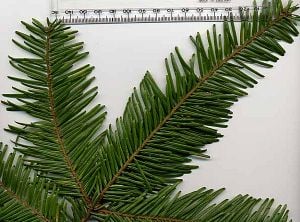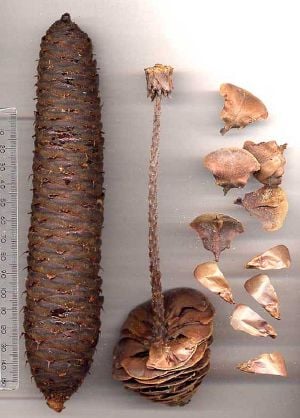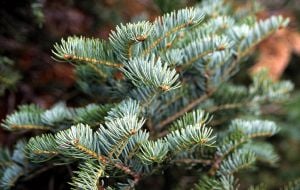Difference between revisions of "Fir" - New World Encyclopedia
Rick Swarts (talk | contribs) (added claimed tag) |
Rosie Tanabe (talk | contribs) |
||
| (12 intermediate revisions by 5 users not shown) | |||
| Line 1: | Line 1: | ||
| − | {{ | + | {{Approved}}{{Images OK}}{{Submitted}}{{Paid}}{{Copyedited}} |
| + | |||
| + | {{Taxobox | ||
| + | | color = lightgreen | ||
| + | | name = ''Abies'' - firs | ||
| + | | image = Abies koreana (szyszki).JPG | ||
| + | | image_width = 230px | ||
| + | | image_caption = [[Korean Fir]] ''(Abies koreana)'' cone and foliage | ||
| + | | regnum = [[Plant]]ae | ||
| + | | divisio = [[Pinophyta]] | ||
| + | | classis = [[Pinophyta|Pinopsida]] | ||
| + | | ordo = [[Pinales]] | ||
| + | | familia = [[Pinaceae]] | ||
| + | | genus = '''''Abies''''' | ||
| + | | genus_authority = [[Philip Miller|Mill.]] | ||
| + | | subdivision_ranks = Species | ||
| + | | subdivision = See text | ||
| + | }} | ||
| + | |||
| + | '''Fir''' is the common name for any of the [[tree#Evergreen versus deciduous|evergreen]] [[tree]]s comprising the genus ''Abies'' of the family [[Pinaceae]], characterized by erect, cylindrical cones that shed their scales and by flattened, stemless, needle-like leaves growing directly from the branches. Fir also refers to the wood of these trees. | ||
| + | |||
| + | Firs provide numerous [[ecology|ecological]], commercial, and aesthetic values. Ecologically, they provide habitat and food for many animals, such as [[insect]] larva. For humans, they provide wood for pulp and for construction (plywood, crates, boxes, interior finishings) and their beauty and fragrance is a reason for their popularity in ornamental plantings and as [[Christmas tree]]s. | ||
| + | {{toc}} | ||
| + | Some other similar trees that are not in the genus ''Abies'', and thus not true firs, also have the common name of fir, such as the Douglas fir ''(Pseudotsuga menziesii)'', whose cones hang downward, unlike true firs (Nix 2006). | ||
| + | [[Image:Abgragra-top.jpg|thumb|right|''Abies grandis'' foliage]] | ||
| + | [[Image:Abies cone & bits.jpg|right|thumb|Intact and disintegrated Bulgarian Fir cones]] | ||
| + | [[Image:Abies_Orjen_foliage.jpg|thumb|right|''Abies alba'' foliage from Dinaric calcareous fir forests on Mt. Orjen]] | ||
| + | |||
| + | ==Description== | ||
| + | |||
| + | True firs comprise the genus ''Abies'', which includes between 45 and 55 diverse [[species]] of [[evergreen]] [[conifer]]s in the family [[Pinaceae]]. All are [[tree]]s, reaching heights of 10-80 meters (30-260 feet) tall, and trunk diameters of 0.5-4 meters (2-12 feet) when mature. | ||
| + | |||
| + | Firs can be distinguished from other members of the pine family, Pinaceae, by their flat, needle-like [[leaf|leaves]], which are attached to the twig by a base that resembles a small suction cup; and by erect, cylindrical [[Conifer cone|cones]], 5-25 centimeters (2-10 inches) long, that disintegrate at maturity to release the winged [[seed]]s, rather than dropping entire. The leaves usually leave a scar when they fall. | ||
| + | |||
| + | Identification of the species is based on the size and arrangement of the leaves, the size and shape of the cones, and whether the bract scales of the cones are long and exserted, or short and hidden inside the cone. | ||
| + | |||
| + | Firs are most closely related to the [[cedar]]s ''(Cedrus)''. Firs are found through much of North and Central America, [[Europe]], [[Asia]], and North [[Africa]], occurring in [[mountain]]s over most of the range. | ||
| + | |||
| + | ==Uses== | ||
| + | The [[wood]] of most firs generally is light and soft and often considered unsuitable for general [[timber]] use. However, it is often used as pulp or for the manufacture of [[plywood]] and rough timber, as well as construction of crates and boxes and for interior finishings. | ||
| + | |||
| + | [[Canada]] balsam, also called Canada turpentine or balsam of fir, is a turpentine that is made from the resin of the balsam fir ''(Abies balsamea)''. | ||
| + | |||
| + | Many firs are valued for their beauty and fragrance, whether as [[Christmas tree]]s or ornamental trees. [[Nordmann Fir]], [[Noble Fir]], [[Fraser Fir]], and [[Balsam Fir]] are very popular Christmas trees, with aromatic foliage that does not shed many needles on drying out. Nix (2006) provides a list of the most popular Christmas trees, with three firs prominent on the list: Fraser fir, ''Abies fraseri'' (most popular); Balsam fir, ''Abies balsamea'' (third); and white fir, ''Abies concolor'' (ninth). Many firs are decorative trees, notably [[Korean Fir]] and Fraser Fir, which produce brightly colored cones even when very young, still only 1-2 meters (3-6 feet) tall. | ||
| + | |||
| + | Firs provide habitat and food for many animals, including the the [[larva]]e of some [[Lepidoptera]] species, including ''[[Chionodes|Chionodes abella]]'' (recorded on [[White Fir]]), [[Autumnal Moth]], [[Korscheltellus|Conifer Swift]] (a pest of [[Balsam Fir]]), [[Engrailed|The Engrailed]], [[Grey Pug]], [[Mottled Umber]], and [[Pine Beauty]]. | ||
| + | |||
| + | ==Classification== | ||
| + | * '''Section ''Balsamea''''' (Taiga|boreal Asia and North America, and high mountains further south) | ||
| + | **''[[Fraser Fir|Abies fraseri]]'' - Fraser Fir | ||
| + | **''[[Balsam Fir|Abies balsamea]]'' - Balsam Fir | ||
| + | ***''Abies balsamea'' var. ''phanerolepis'' - Bracted Balsam Fir | ||
| + | **''[[Subalpine Fir|Abies bifolia]]'' - Rocky Mountains Subalpine Fir | ||
| + | **''[[Subalpine Fir|Abies lasiocarpa]]'' - Coast Range Subalpine Fir | ||
| + | ***''Abies lasiocarpa'' var. ''arizonica'' - Corkbark Fir | ||
| + | **''[[Siberian Fir|Abies sibirica]]'' - Siberian Fir | ||
| + | **''[[Sakhalin Fir|Abies sachalinensis]]'' - Sakhalin Fir | ||
| + | **''[[Korean Fir|Abies koreana]]'' - Korean Fir | ||
| + | **''[[Khinghan Fir|Abies nephrolepis]]'' - Khinghan Fir | ||
| + | **''[[Veitch's Fir|Abies veitchii]]'' - Veitch's Fir | ||
| + | ***''Abies veitchii'' var. ''sikokiana'' - Shikoku Fir | ||
| + | |||
| + | * '''Section ''Grandis''''' (western North America to Mexico and Guatemala, lowlands in north, moderate altitudes in south) | ||
| + | **''[[Grand Fir|Abies grandis]]'' - Grand Fir or Giant Fir | ||
| + | ***''Abies grandis'' var. ''idahoensis'' - Interior Grand Fir or Giant Fir | ||
| + | **''[[White Fir|Abies concolor]]'' - White Fir | ||
| + | ***''Abies concolor'' subsp. ''lowiana'' - Low's White Fir | ||
| + | **''[[Durango Fir|Abies durangensis]]'' - Durango Fir | ||
| + | ***''Abies durangensis'' var. ''coahuilensis'' - Coahuila Fir | ||
| + | **''[[Jalisco Fir|Abies flinckii]]'' - Jalisco Fir | ||
| + | **''[[Guatemalan Fir|Abies guatemalensis]]'' - Guatemalan Fir | ||
| + | |||
| + | * '''Section ''Abies''''' (central, south & east Europe, Asia Minor) | ||
| + | **''[[Sicilian Fir|Abies nebrodensis]]'' - Sicilian Fir | ||
| + | **''[[Silver Fir|Abies alba]]'' - Silver Fir | ||
| + | **''[[Bulgarian Fir|Abies borisii-regis]]'' - Bulgarian Fir | ||
| + | **''[[Greek Fir|Abies cephalonica]]'' - Greek Fir | ||
| + | **''[[Nordmann Fir|Abies nordmanniana]]'' - Nordmann Fir or Caucasian Fir | ||
| + | ***''Abies nordmanniana'' subsp. ''equi-trojani'' - Turkish Fir | ||
| + | **''[[Cilician Fir|Abies cilicica]]'' - Cilician Fir | ||
| + | |||
| + | * '''Section ''Piceaster''''' (southern Spain, northwest Africa) | ||
| + | **''[[Spanish Fir|Abies pinsapo]]'' - Spanish Fir | ||
| + | ***''Abies pinsapo'' var. ''marocana'' - Moroccan Fir | ||
| + | **''[[Algerian Fir|Abies numidica]]'' - Algerian Fir | ||
| + | |||
| + | * '''Section ''Momi''''' (east & central Asia, Himalaya, generally at low to moderate altitudes) | ||
| + | **''[[Taiwan Fir|Abies kawakamii]]'' - Taiwan Fir | ||
| + | **''[[Nikko Fir|Abies homolepis]]'' - Nikko Fir | ||
| + | **''[[Min Fir|Abies recurvata]]'' - Min Fir | ||
| + | ***''Abies recurvata'' var. ''ernestii'' - Min Fir | ||
| + | **''[[Momi Fir|Abies firma]]'' - Momi Fir | ||
| + | **''[[Baishanzu Fir|Abies beshanzuensis]]'' - Baishanzu Fir | ||
| + | **''[[Manchurian Fir|Abies holophylla]]'' - Manchurian Fir | ||
| + | **''[[Shensi Fir|Abies chensiensis]]'' - Shensi Fir | ||
| + | ***''Abies chensiensis'' subsp. ''salouenensis'' - Salween Fir | ||
| + | **''[[Pindrow Fir|Abies pindrow]]'' - Pindrow Fir | ||
| + | **''[[Ziyuan Fir|Abies ziyuanensis]]'' - Ziyuan Fir | ||
| + | |||
| + | * '''Section ''Amabilis''''' (Pacific coast mountains, North America and Japan, in high rainfall mountains) | ||
| + | **''[[Pacific Silver Fir|Abies amabilis]]'' - Pacific Silver Fir | ||
| + | **''[[Maries' Fir|Abies mariesii]]'' - Maries' Fir | ||
| + | |||
| + | * '''Section ''Pseudopicea''''' ([[Himalaya|Sino-Himalayan mountains]], at high altitude) | ||
| + | **''[[Delavay's Fir|Abies delavayi]]'' - Delavay's Fir | ||
| + | **''[[Faber's Fir|Abies fabri]]'' - Faber's Fir | ||
| + | **''[[Forrest's Fir|Abies forrestii]]'' - Forrest's Fir | ||
| + | **''[[Cheng's Fir|Abies chengii]]'' - Cheng's Fir | ||
| + | **''[[Bhutan Fir|Abies densa]]'' - Bhutan Fir | ||
| + | **''[[East Himalayan Fir|Abies spectabilis]]'' - East Himalayan Fir | ||
| + | **''[[Farges' Fir|Abies fargesii]]'' - Farges' Fir | ||
| + | **''[[Fanjingshan Fir|Abies fanjingshanensis]]'' - Fanjingshan Fir | ||
| + | **''[[Yuanbaoshan Fir|Abies yuanbaoshanensis]]'' - Yuanbaoshan Fir | ||
| + | **''[[Flaky Fir|Abies squamata]]'' - Flaky Fir | ||
| + | |||
| + | * '''Section ''Oiamel''''' ([[Mexico]], high altitudes in mountains) | ||
| + | **''[[Sacred Fir|Abies religiosa]]'' - Sacred Fir | ||
| + | **''[[Abies vejarii]]'' - Vejar's Fir | ||
| + | ***''Abies vejarii'' var. ''mexicana'' - Mexican Fir | ||
| + | **''[[Hickel's Fir|Abies hickelii]]'' - Hickel's Fir | ||
| + | ***''Abies hickelii'' var. ''oaxacana'' - Oaxaca Fir | ||
| + | |||
| + | * '''Section ''Nobilis''''' (western [[United States|USA]], high altitudes) | ||
| + | **''[[Noble Fir|Abies procera]]'' - Noble Fir | ||
| + | **''[[Red Fir|Abies magnifica]]'' - Red Fir | ||
| + | ***''Abies magnifica'' var. ''shastensis'' - Shasta Red Fir | ||
| + | |||
| + | * '''Section ''Bracteata''''' ([[California]] coast) | ||
| + | **''[[Bristlecone Fir|Abies bracteata]]'' - Bristlecone Fir | ||
| + | |||
| + | ==References== | ||
| + | * Dallimore, W., and A. B. Jackson. Revised by S. G. Harrison. 1967. ''A Handbook of Coniferae and Ginkgoaceae''. New York: St. Martin's Press. | ||
| + | * Nix, S. 2006. [http://forestry.about.com/cs/christmastrees1/a/top10_xmastree.htm Top ten Christmas tree species sold in North America]. About.com. Retrieved September 16, 2007. | ||
| + | * Pielou, E. C. 1988. ''The World of Northern Evergreens''. Ithica, NY: Cornell University Press. ISBN 0801421160 | ||
| + | |||
| + | ==External Links== | ||
| + | All links retrieved March 26, 2024. | ||
| + | |||
| + | * [http://www.pinetum.org/cones/ABIEScones.htm Arboretum de Villardebelle cone photos: Images of cones of selected species]. | ||
| + | |||
| + | [[Category:Life sciences]] | ||
| + | [[Category:Plants]] | ||
| + | {{credit|Fir|155626847|Canada_balsam|155874181}} | ||
Latest revision as of 19:50, 26 March 2024
| Abies - firs | ||||||||||||
|---|---|---|---|---|---|---|---|---|---|---|---|---|
 Korean Fir (Abies koreana) cone and foliage
| ||||||||||||
| Scientific classification | ||||||||||||
| ||||||||||||
|
See text |
Fir is the common name for any of the evergreen trees comprising the genus Abies of the family Pinaceae, characterized by erect, cylindrical cones that shed their scales and by flattened, stemless, needle-like leaves growing directly from the branches. Fir also refers to the wood of these trees.
Firs provide numerous ecological, commercial, and aesthetic values. Ecologically, they provide habitat and food for many animals, such as insect larva. For humans, they provide wood for pulp and for construction (plywood, crates, boxes, interior finishings) and their beauty and fragrance is a reason for their popularity in ornamental plantings and as Christmas trees.
Some other similar trees that are not in the genus Abies, and thus not true firs, also have the common name of fir, such as the Douglas fir (Pseudotsuga menziesii), whose cones hang downward, unlike true firs (Nix 2006).
Description
True firs comprise the genus Abies, which includes between 45 and 55 diverse species of evergreen conifers in the family Pinaceae. All are trees, reaching heights of 10-80 meters (30-260 feet) tall, and trunk diameters of 0.5-4 meters (2-12 feet) when mature.
Firs can be distinguished from other members of the pine family, Pinaceae, by their flat, needle-like leaves, which are attached to the twig by a base that resembles a small suction cup; and by erect, cylindrical cones, 5-25 centimeters (2-10 inches) long, that disintegrate at maturity to release the winged seeds, rather than dropping entire. The leaves usually leave a scar when they fall.
Identification of the species is based on the size and arrangement of the leaves, the size and shape of the cones, and whether the bract scales of the cones are long and exserted, or short and hidden inside the cone.
Firs are most closely related to the cedars (Cedrus). Firs are found through much of North and Central America, Europe, Asia, and North Africa, occurring in mountains over most of the range.
Uses
The wood of most firs generally is light and soft and often considered unsuitable for general timber use. However, it is often used as pulp or for the manufacture of plywood and rough timber, as well as construction of crates and boxes and for interior finishings.
Canada balsam, also called Canada turpentine or balsam of fir, is a turpentine that is made from the resin of the balsam fir (Abies balsamea).
Many firs are valued for their beauty and fragrance, whether as Christmas trees or ornamental trees. Nordmann Fir, Noble Fir, Fraser Fir, and Balsam Fir are very popular Christmas trees, with aromatic foliage that does not shed many needles on drying out. Nix (2006) provides a list of the most popular Christmas trees, with three firs prominent on the list: Fraser fir, Abies fraseri (most popular); Balsam fir, Abies balsamea (third); and white fir, Abies concolor (ninth). Many firs are decorative trees, notably Korean Fir and Fraser Fir, which produce brightly colored cones even when very young, still only 1-2 meters (3-6 feet) tall.
Firs provide habitat and food for many animals, including the the larvae of some Lepidoptera species, including Chionodes abella (recorded on White Fir), Autumnal Moth, Conifer Swift (a pest of Balsam Fir), The Engrailed, Grey Pug, Mottled Umber, and Pine Beauty.
Classification
- Section Balsamea (Taiga|boreal Asia and North America, and high mountains further south)
- Abies fraseri - Fraser Fir
- Abies balsamea - Balsam Fir
- Abies balsamea var. phanerolepis - Bracted Balsam Fir
- Abies bifolia - Rocky Mountains Subalpine Fir
- Abies lasiocarpa - Coast Range Subalpine Fir
- Abies lasiocarpa var. arizonica - Corkbark Fir
- Abies sibirica - Siberian Fir
- Abies sachalinensis - Sakhalin Fir
- Abies koreana - Korean Fir
- Abies nephrolepis - Khinghan Fir
- Abies veitchii - Veitch's Fir
- Abies veitchii var. sikokiana - Shikoku Fir
- Section Grandis (western North America to Mexico and Guatemala, lowlands in north, moderate altitudes in south)
- Abies grandis - Grand Fir or Giant Fir
- Abies grandis var. idahoensis - Interior Grand Fir or Giant Fir
- Abies concolor - White Fir
- Abies concolor subsp. lowiana - Low's White Fir
- Abies durangensis - Durango Fir
- Abies durangensis var. coahuilensis - Coahuila Fir
- Abies flinckii - Jalisco Fir
- Abies guatemalensis - Guatemalan Fir
- Abies grandis - Grand Fir or Giant Fir
- Section Abies (central, south & east Europe, Asia Minor)
- Abies nebrodensis - Sicilian Fir
- Abies alba - Silver Fir
- Abies borisii-regis - Bulgarian Fir
- Abies cephalonica - Greek Fir
- Abies nordmanniana - Nordmann Fir or Caucasian Fir
- Abies nordmanniana subsp. equi-trojani - Turkish Fir
- Abies cilicica - Cilician Fir
- Section Piceaster (southern Spain, northwest Africa)
- Abies pinsapo - Spanish Fir
- Abies pinsapo var. marocana - Moroccan Fir
- Abies numidica - Algerian Fir
- Abies pinsapo - Spanish Fir
- Section Momi (east & central Asia, Himalaya, generally at low to moderate altitudes)
- Abies kawakamii - Taiwan Fir
- Abies homolepis - Nikko Fir
- Abies recurvata - Min Fir
- Abies recurvata var. ernestii - Min Fir
- Abies firma - Momi Fir
- Abies beshanzuensis - Baishanzu Fir
- Abies holophylla - Manchurian Fir
- Abies chensiensis - Shensi Fir
- Abies chensiensis subsp. salouenensis - Salween Fir
- Abies pindrow - Pindrow Fir
- Abies ziyuanensis - Ziyuan Fir
- Section Amabilis (Pacific coast mountains, North America and Japan, in high rainfall mountains)
- Abies amabilis - Pacific Silver Fir
- Abies mariesii - Maries' Fir
- Section Pseudopicea (Sino-Himalayan mountains, at high altitude)
- Abies delavayi - Delavay's Fir
- Abies fabri - Faber's Fir
- Abies forrestii - Forrest's Fir
- Abies chengii - Cheng's Fir
- Abies densa - Bhutan Fir
- Abies spectabilis - East Himalayan Fir
- Abies fargesii - Farges' Fir
- Abies fanjingshanensis - Fanjingshan Fir
- Abies yuanbaoshanensis - Yuanbaoshan Fir
- Abies squamata - Flaky Fir
- Section Oiamel (Mexico, high altitudes in mountains)
- Abies religiosa - Sacred Fir
- Abies vejarii - Vejar's Fir
- Abies vejarii var. mexicana - Mexican Fir
- Abies hickelii - Hickel's Fir
- Abies hickelii var. oaxacana - Oaxaca Fir
- Section Nobilis (western USA, high altitudes)
- Abies procera - Noble Fir
- Abies magnifica - Red Fir
- Abies magnifica var. shastensis - Shasta Red Fir
- Section Bracteata (California coast)
- Abies bracteata - Bristlecone Fir
ReferencesISBN links support NWE through referral fees
- Dallimore, W., and A. B. Jackson. Revised by S. G. Harrison. 1967. A Handbook of Coniferae and Ginkgoaceae. New York: St. Martin's Press.
- Nix, S. 2006. Top ten Christmas tree species sold in North America. About.com. Retrieved September 16, 2007.
- Pielou, E. C. 1988. The World of Northern Evergreens. Ithica, NY: Cornell University Press. ISBN 0801421160
External Links
All links retrieved March 26, 2024.
Credits
New World Encyclopedia writers and editors rewrote and completed the Wikipedia article in accordance with New World Encyclopedia standards. This article abides by terms of the Creative Commons CC-by-sa 3.0 License (CC-by-sa), which may be used and disseminated with proper attribution. Credit is due under the terms of this license that can reference both the New World Encyclopedia contributors and the selfless volunteer contributors of the Wikimedia Foundation. To cite this article click here for a list of acceptable citing formats.The history of earlier contributions by wikipedians is accessible to researchers here:
The history of this article since it was imported to New World Encyclopedia:
Note: Some restrictions may apply to use of individual images which are separately licensed.


